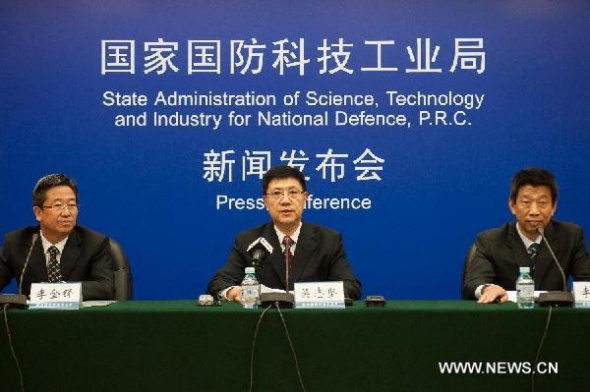

Wu Zhijian (C), spokesman with the State Administration of Science, Technology and Industry for National Defense, introduces China's lunar probe at a press conference in Beijing, capital of China, Nov. 26, 2013. China is scheduled to launch Chang'e-3 lunar probe to the moon in early December, marking the first time for a Chinese spacecraft to soft-land on the surface of an extraterrestrial body, the official said Tuesday. (Xinhua/Liu Jinhai)
China is scheduled to launch Chang'e-3 lunar probe to the moon in early December, the first time a Chinese spacecraft will soft-land on the surface of an extraterrestrial body, an official said Tuesday.
Chang'e-3 comprises a lander and a moon rover called "Yutu" (Jade Rabbit). The lunar probe will land on the moon in mid-December if everything goes according to plan, said Wu Zhijian, spokesman with State Administration of Science, Technology and Industry for National Defence(SASTIND).
Tasks for Yutu include surveying the moon's geological structure and surface substances, while looking for natural resources, Ouyang Ziyuan, chief scientist of China's lunar orbiter project, said in an interview with Xinhua.
Yutu will land in Sinus Iridum, or the Bay of Rainbows, and operate there for three months. It can travel at a speed of 200 meters per hour.
The Bay of Rainbows was selected because the level terrain will enable smooth communication and ample sunshine. Previous lunar missions were near the lunar equator and no country has surveyed the area yet. The Bay of Rainbows was "left blank" in the study of the moon, said the scientist.
The Chang'e-3 mission is the second phase of China's lunar program, which includes orbiting, landing and returning to Earth. It follows the success of the Chang'e-1 and Chang'e-2 missions in 2007 and 2010.
Chinese scientists have made technological breakthroughs for Chang'e-3, which will be the most complicated and difficult task in China's space exploration, SASTIND spokesman Wu said.
"More than 80 percent of the technology adopted in the mission is new," he said.
The mission will be China's first exploration of an extraterrestrial object using remote control of a lunar probe and deep space communication, Wu said.
Narrow time windows mean a timely launch is essential. Different trajectory parameters have to be adapted quickly as intervals between the windows are very short, he said.
Many technologies will be used to ensure the probe makes a soft-landing in low-gravity conditions. The rover will separate from the lander to the explore area around the landing site.
The lunar program will also see breakthroughs in remote control between the moon and Earth. Technologies of high precision observation and control as well as lunar positioning will be used in the mission, which includes experiments that would be extremely difficult to conduct on Earth's surface, he said.
Copyright ©1999-2018
Chinanews.com. All rights reserved.
Reproduction in whole or in part without permission is prohibited.